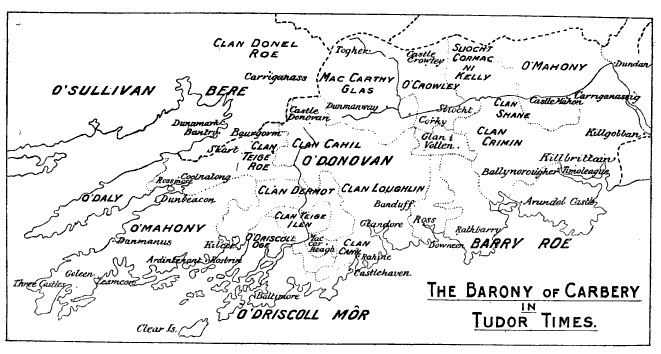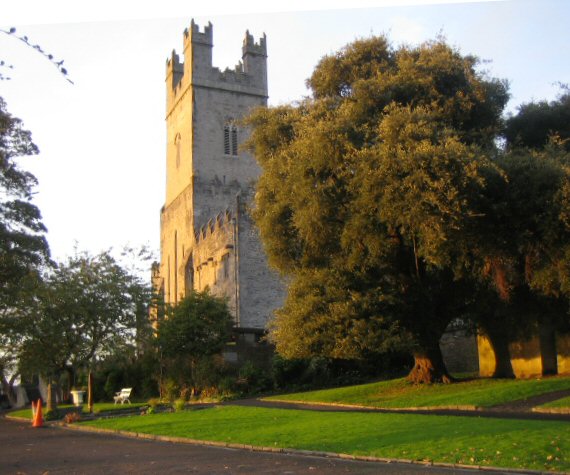|
Saint Fachanan
Saint Fachanan (also known as Fachtna), belonged to the ancient princely race of the Corcu Loígde. Very little is known with certainty about Fachanan. He is linked by a strong early tradition with Kilfenora, where he founded a monastery in the sixth century. He is venerated as the first Bishop of Kilfenora. In the Roman Catholic Church, this diocese is now administered by the Diocese of Galway and in the Anglican church by the Diocese of Limerick and Killaloe The Diocese of Limerick and Killaloe (formally: 'The United Dioceses of Limerick, Ardfert, Aghadoe, Killaloe, Kilfenora, Clonfert, Kilmacduagh and Emly') was a former diocese of the Church of Ireland that was located in mid-western Irelan .... His feast day is 20 December. Saint Fachtna of Ross (feast day: formerly 14 August, now 13 August) was also called Fachanan. References External linksSaint Fachananat Patron Saints Index 6th-century Christian saints 6th-century Irish bishops People from Count ... [...More Info...] [...Related Items...] OR: [Wikipedia] [Google] [Baidu] [Amazon] |
Corcu Loígde
The Corcu Loígde (Corcu Lóegde, Corco Luigde, Corca Laoighdhe, Laidhe), meaning Gens of the Calf Goddess, also called the Síl Lugdach meic Itha, were a kingdom centred in West County Cork who descended from the proto-historical rulers of Munster, the Dáirine, of whom they were the central royal sept. They took their name from Lugaid Loígde "Lugaid of the Calf Goddess", a King of Tara and High King of Ireland, son of the great Dáire Doimthech (a quo Dáirine). A descendant of Lugaid Loígde, and their most famous ancestor, is the legendary Lugaid Mac Con, who is listed in the Old Irish '' Baile Chuinn Chétchathaig''. Closest kin to the Corcu Loígde were the Dál Fiatach princes of the Ulaid. Overview The Corcu Loígde were the rulers of Munster, and likely of territories beyond the province, until the early 7th century AD, when their ancient alliance with the Kingdom of Osraige fell apart as the Eóganachta rose to power. Many peoples formerly subject to the Co ... [...More Info...] [...Related Items...] OR: [Wikipedia] [Google] [Baidu] [Amazon] |
Kilfenora
Kilfenora ( , meaning 'church of the fertile hillside' or 'church of the white brow') is a village and a civil parish in County Clare, Ireland. It is situated south of the karst limestone region known as the Burren. Since medieval times when it was the episcopal see of the Bishop of Kilfenora, it has been known as the "City of the Crosses" for its seven (now five) high crosses. The village had around 150 inhabitants in 2022. Much of the TV show ''Father Ted'' (1995–98) was filmed there. Name ''Cill Fhionnúrach'' is generally translated as "church of the fertile hillside", "church of the white brow" or "church of the white meadow". The village and diocese of Kilfenora have also been referred to as Fenebore, Kilfenoragh, Finneborensis or Collumabrach. Village According to the Census of 2011, 463 people lived in the Kilfenora area, up from 409 in 2006. However, most of them do not live inside the village. In 2011, there were just 220 inhabitants in the village proper, up fr ... [...More Info...] [...Related Items...] OR: [Wikipedia] [Google] [Baidu] [Amazon] |
Bishop Of Kilfenora
The Bishop of Kilfenora () was a distinct episcopal title which took its name from the village of Kilfenora in County Clare in the Republic of Ireland. In both the Church of Ireland and the Roman Catholic Church, the title is now united with other bishoprics. History The monastery at Kilfenora was reportedly founded by Saint Fachanan in the sixth century. It was not until March 1152 that the diocese of Kilfenora was established at the Synod of Kells. The diocese corresponded with the ancient territory of Corcomroe., ''The Province of Munster'', p. 500. Part of the Archdiocese of Cashel, it only extended over 200 square miles of very thinly populated land. It was reckoned the poorest diocese, with only 13 parishes. Demand for the position of bishop thus was not great, but for 1189 a bishop is recorded. In 1660, Samuel Pullen was made Archbishop of Tuam and Kilfenora became part of his province. After the Reformation, there were parallel paths of succession. In the Church of Ir ... [...More Info...] [...Related Items...] OR: [Wikipedia] [Google] [Baidu] [Amazon] |
Roman Catholic Diocese Of Galway, Kilmacduagh And Kilfenora
The Diocese of Galway, Kilmacduagh and Kilfenora () is a Latin Church diocese of the Catholic Church in the west of Republic of Ireland, Ireland. It is in the ecclesiastical province of Tuam and is subject to the Metropolitan Archdiocese of Roman Catholic Archdiocese of Tuam, Tuam. The deanery of Kilfenora, previously a diocese in its own right, lies in the ecclesiastical province of Roman Catholic Archdiocese of Cashel and Emly, Cashel. The Ordinary (Catholic Church), ordinary is Bishop Michael Duignan (bishop), Michael Duignan who was appointed on 11 February 2022. Geographic remit The geographic remit of the Episcopal see, see includes the Galway, City of Galway, parts of the County Galway, county of Galway and the northern coastal part of County Clare. Large population centres include Ennistymon, Oranmore and Oughterard. The cathedral church of the diocese is the Galway Cathedral, Cathedral of Our Lady Assumed into Heaven and St Nicholas. Ecclesiastical history The diocese h ... [...More Info...] [...Related Items...] OR: [Wikipedia] [Google] [Baidu] [Amazon] |
Diocese Of Limerick And Killaloe
The Diocese of Limerick and Killaloe (formally: 'The United Dioceses of Limerick, Ardfert, Aghadoe, Killaloe, Kilfenora, Clonfert, Kilmacduagh and Emly') was a former diocese of the Church of Ireland that was located in mid-western Ireland. The diocese was formed by a merger of neighbouring dioceses in 1976, before itself merging with the neighbouring Diocese of Tuam in 2022 to form the Diocese of Tuam, Limerick and Killaloe. The diocese was in the ecclesiastical province of Dublin and was one of the twelve Church of Ireland dioceses that cover the whole of Ireland. The diocese covered all of counties Limerick, Kerry and Clare, plus parts of counties Galway, Cork and Tipperary. Overview and history After the Church of England and the Roman Catholic Church broke communion, by decree of the Irish Parliament, the Church of Ireland became the independent State Church of the Kingdom of Ireland. It assumed possession of most Church property (and so retained a great repo ... [...More Info...] [...Related Items...] OR: [Wikipedia] [Google] [Baidu] [Amazon] |
Saint Fachtna
Fachtna of Rosscarbery, known also as Fachanan, was an Irish Christian leader known as the founder of the monastery of Rosscarbery (Ros Ailithir), County Cork. He died around 600. Life He established a monastery and school in the area now known as Rosscarbery towards the end of the sixth century. His monastery became the principal monastery of west Cork, and later had a famous Scripture school known as the School of Ross. Brendan, the Navigator, taught in this school, which was crowded with students from every land. It flourished for three hundred years and survived in some form until the coming of the Normans to Ireland. It was the centre from which the Diocese of Ross developed. Fachtna, born at a place called Tulachteann, was one of the pupils of Saint Ita. It is said that Fachtna was cured of an affection of his eyes by bathing them in the milk of Saint Mochoemoc's mother, Saint Ita's sister. He then studied at Saint Finbarr's school at Loch Eirce (Gougane Barra). Before ... [...More Info...] [...Related Items...] OR: [Wikipedia] [Google] [Baidu] [Amazon] |
Diocese Of Ross, Ireland
The Diocese of Ross was a separate diocese situated in south-west Ireland. Following the Reformation, there were two dioceses. In the Church of Ireland, the diocese is now part of the Diocese of Cork, Cloyne and Ross. In the Roman Catholic Church, it is part of the Diocese of Cork and Ross. In the 19th century, an exclave of the diocese existed around that part of the Beara peninsula in County Cork including the area around Glengariff though not as far east as Bantry. The main diocesan territory was centred on the towns of Baltimore, Skibbereen, Rosscarbery and Clonakilty which lie along the modern national road N71. History This see was founded by St. Fachtna, and the place-name was variously known as Ros Cairbre (Rosscarbery) and Ros Ailithir (Ross of the pilgrims). St. Fachtna founded the School of Ross as well as the see; and his death occurred about 590, on 14 August, on which day his feast is celebrated. At that time the chiefs of the tuath were the O'Leary, known as ... [...More Info...] [...Related Items...] OR: [Wikipedia] [Google] [Baidu] [Amazon] |
6th-century Christian Saints
The 6th century is the period from 501 through 600 in line with the Julian calendar. In the West, the century marks the end of Classical Antiquity and the beginning of the Middle Ages. The collapse of the Western Roman Empire late in the previous century left Europe fractured into many small Germanic kingdoms competing fiercely for land and wealth. From the upheaval the Franks rose to prominence and carved out a sizeable domain covering much of modern France and Germany. Meanwhile, the surviving Eastern Roman Empire began to expand under Emperor Justinian, who recaptured North Africa from the Vandals and attempted fully to recover Italy as well, in the hope of reinstating Roman control over the lands once ruled by the Western Roman Empire. Owing in part to the collapse of the Roman Empire along with its literature and civilization, the sixth century is generally considered to be the least known about in the Dark Ages (historiography), Dark Ages. In its second golden age, the ... [...More Info...] [...Related Items...] OR: [Wikipedia] [Google] [Baidu] [Amazon] |
People From County Clare
The term "the people" refers to the public or common mass of people of a polity. As such it is a concept of human rights law, international law as well as constitutional law, particularly used for claims of popular sovereignty. In contrast, a people is any plurality of persons considered as a whole. Used in politics and law, the term "a people" refers to the collective or community of an ethnic group or nation. Concepts Legal Chapter One, Article One of the Charter of the United Nations states that "peoples" have the right to self-determination. Though the mere status as peoples and the right to self-determination, as for example in the case of Indigenous peoples (''peoples'', as in all groups of indigenous people, not merely all indigenous persons as in ''indigenous people''), does not automatically provide for independent sovereignty and therefore secession. Indeed, judge Ivor Jennings identified the inherent problems in the right of "peoples" to self-determination, as i ... [...More Info...] [...Related Items...] OR: [Wikipedia] [Google] [Baidu] [Amazon] |



